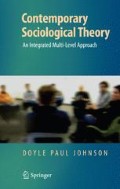This chapter moves beyond the dominant image in Parsons’ theory of a stable social order characterized by a shared value system that promotes harmonious interdependence. By modifying functional analysis through the perspectives to be reviewed in this chapter, we will see how the social consequences of people’s behavior vary greatly for different participants and systems. In addition, although cultural ideals and values may be important in efforts to sustain the social order, they are inadequate by themselves in explaining the dynamics of people’s social actions. People’s motivations also reflect their interests, and their actions always involve a subjective assessment of how the relevant values and norms apply (or don’t apply) to their particular situation. The specific theoretical perspectives to be covered in this chapter are as follows:
-
Robert K. Merton’s strategy for “middle-range” functional analysis—As explained in Chapter 3, Merton was critical of Parsons’ overly abstract “grand” theory, even when functionalism was still dominant. Instead of making claims about functional requirements, his alternative focus involved exploring how individuals’ actions contribute to social outcomes that may or may not be consciously intended, both functional and dysfunctional.
-
Emergence of the “neofunctional” perspective—Following the decline of functionalism in the late 1960s and early 1970s, functionalism experienced a revival in the 1980s with the development of neofunctionalism. Although the earlier dominance of functional theory was not restored, neofunctionalism is an important contemporary perspective, particularly as represented by the contributions of American sociologist Jeffrey Alexander and German sociologist Richard Münch.
-
Jeffrey Alexander’s multidimensional analysis of the interdependent dynamics of social action and order—Alexander emphasizes the challenge of explaining social order, but social processes promoting social order through normative commitments must be balanced by explicit recognition of conflicting interests, environmental conditions and constraints, and the unforeseen contingencies individuals face in dealing with the particular situations in which they find themselves.
-
Richard Münch’s multidimensional analysis of social action—As we shall see Münch used Parsons’ AGIL perspective to analyze the dynamics of social action in terms of symbolic complexity at the level of meaning and contingency at the level of individuals’ choices. His perspective indicates that all actions can be analyzed in terms of their economic, political, socioemotional, and value orientational dimensions.
-
Access this chapter
Tax calculation will be finalised at checkout
Purchases are for personal use only
Preview
Unable to display preview. Download preview PDF.
Rights and permissions
Copyright information
© 2008 Springer Science+Business Media, LLC
About this chapter
Cite this chapter
(2008). Middle-Range Functionalism and Neofunctionalism. In: Contemporary Sociological Theory. Springer, New York, NY. https://doi.org/10.1007/978-0-387-76522-8_13
Download citation
DOI: https://doi.org/10.1007/978-0-387-76522-8_13
Publisher Name: Springer, New York, NY
Print ISBN: 978-0-387-76521-1
Online ISBN: 978-0-387-76522-8
eBook Packages: Humanities, Social Sciences and LawSocial Sciences (R0)

